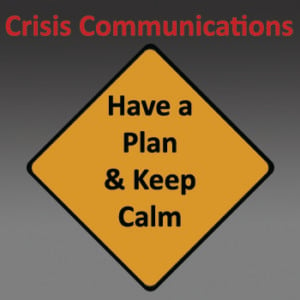 Fake bank accounts, food-borne illnesses, smartphones catching fire, cyber breaches. These are just a handful of recent events that have played out in the news and flooded social media, exponentially effecting conversations, comments and opinions, and most importantly, reputation and revenue. One thing that all of these seemingly different events have in common is that each one can be classified as a crisis, and require a thoughtful and carefully orchestrated response.
Fake bank accounts, food-borne illnesses, smartphones catching fire, cyber breaches. These are just a handful of recent events that have played out in the news and flooded social media, exponentially effecting conversations, comments and opinions, and most importantly, reputation and revenue. One thing that all of these seemingly different events have in common is that each one can be classified as a crisis, and require a thoughtful and carefully orchestrated response.
How a company or organization handles crisis and communicates with its stakeholders can greatly impact its reputation, brand image, trust factor, future sales and ability to recover. With our 24/7 news cycle, having a crisis communications preparedness plan is essential. While typically viewed from “the outside looking in” as a public relations function, there’s another aspect: forward-thinking companies incorporate crisis management planning into their risk management process, to identify various potential situations that require crisis communications. Having an approved, pre-written response, with clear and consistent messaging, that can, of course, be tailored to a specific event, is a tool that will keep things focused on the crisis at hand and allow for a more fluid process and better communication to stakeholders as well as clients and consumers.
During an emergency, communication is priority number one, and being able to quickly reach your desired audience becomes vital to any team designated to respond. In addition to a consistent, transparent, accurate message, protocols and timely updates, companies should identify:
- The audience(s) needed to be addressed, whether it be employees, insurance carriers, brokers, clients, consumers, the media, government, or everyone in its network;
- The means through which the message will be delivered, such as a press release or live statement, email, social media networks, company website alert banner, setting up an information center or hotline, posting a dedicated crisis page or a combination of these;
- Who from the organization is designated to respond to comments on social media and the news media – it is absolutely essential to have a policy in place for media communications/authorized spokespersons as part of employee orientation/communication;
- Create a decision tree to guide the crisis team through next steps.
Utilizing social media to engage your audience has evolved into the mix of traditional communication methods essential for any crisis response team. By providing a live stream of the situation, you can be proactive, tell the story with transparency, and what you are doing to remedy those who were impacted. This affords you the best potential to manage the message.
Whether you choose to use Twitter, Facebook, Google or any other social media network to engage your target audience as part of your crisis communications strategy, being a trustworthy source of information with a consistent position on the available facts and, ultimately, a message and plan to communicate how the situation is being addressed and remedied are paramount aspects of any crisis plan.
Using the company website to alert your network during a time of crisis is a good way to communicate; this can be done using the Internet, or by using the company’s intranet so only employees are reached. Having a corporate social media policy in place as part of the organization’s key elements is the best possible way of managing what is communicated by employees on any company asset.
Having a dedicated emergency page which remains private or ”dark” until a situation occurs is a great way to prepare to react when an emergency occurs; having a template style page which can be easily amended appropriately will provide your company the ability to react quickly during ominous times.
Seeking guidance from risk management experts who can go beyond communications and identify potential risk in a variety of situations is a type of due diligence that can prove to be invaluable. These are just a few ways to help prepare response teams for critical situations; if you would like to discuss additional ways to improve or create a crisis communications strategy for your organization, please contact me at nsica@thealsgroup.com or at 732.395.4263.


